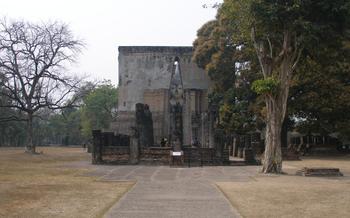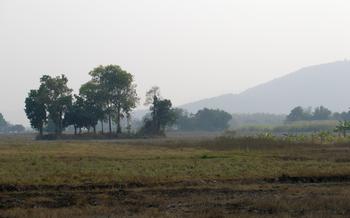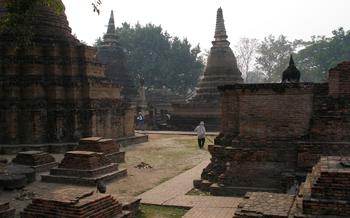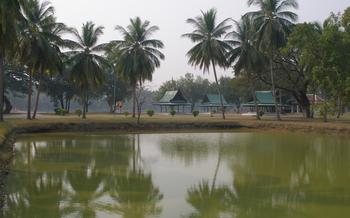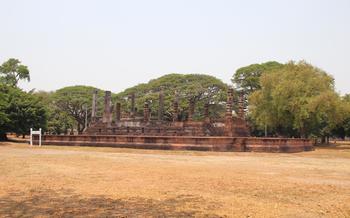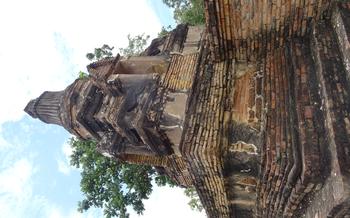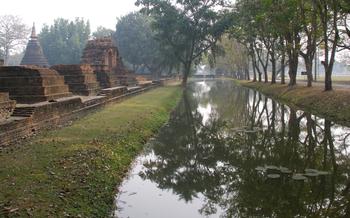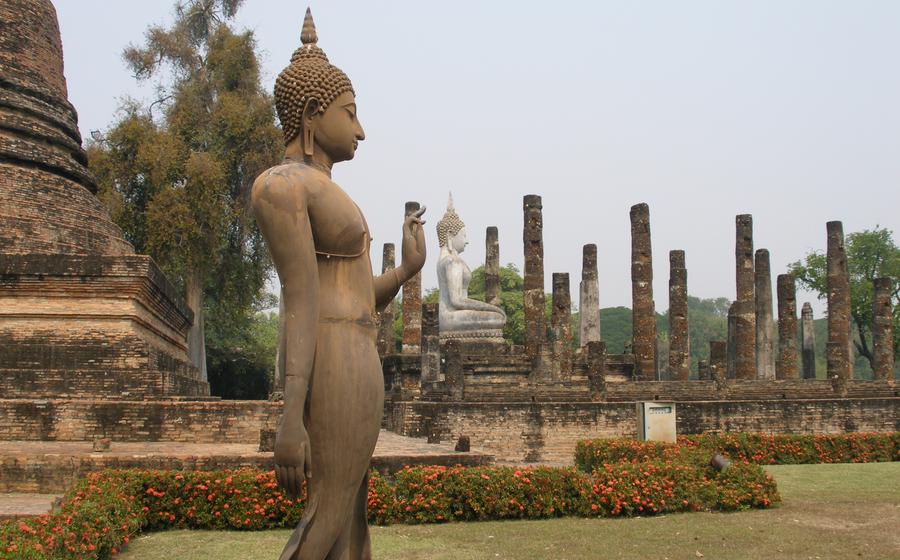
Ban Mo Miang Community
- The Ban Mo Miang Community: A Unique Experience
- Exploring Mo Miang Heritage Park
- Ban Mo Miang Handicrafts
- Ban Mo Miang Homestay Experience
- Forest Bathing in Ban Mo Miang
- Authentic Thai Cooking Classes
- Exploring the Village Temple
- Elephant Sanctuary Visit
- Local Markets and Street Food
- Hilltribe Villages in the Area
- Sukhothai Historical Park: A Journey Through Ancient Ruins
- Wat Si Chum: Unveiling the Serenity and Grandeur
- Wat Saphan Hin: Serenity and Picturesque Beauty
- Nightlife and Entertainment
- Insider Tip: Hidden Gem
The Ban Mo Miang Community: A Unique Experience
Historical Background and Significance The Ban Mo Miang Community, located in the Sukhothai province of Thailand, holds a unique place in the country's cultural heritage. Established over 700 years ago by skilled artisans who migrated from the ancient Lanna Kingdom, the community has preserved its traditional way of life and craftsmanship techniques, passing them down from generation to generation.
Location and Accessibility Nestled amidst serene rice paddies and lush forests, Ban Mo Miang is situated about 20 kilometers from the city of Sukhothai. Visitors can easily reach the community by local transportation or by renting a bicycle for a scenic ride through the countryside.
Unique Identity and Lifestyle The Ban Mo Miang community is renowned for its distinct lifestyle and cultural practices. The villagers maintain a strong sense of community, working together to preserve their traditions and crafts. Visitors can witness the locals engaged in various activities, such as weaving, pottery, and woodworking, while immersing themselves in the community's warm hospitality.
Sustainable Tourism Ban Mo Miang embraces sustainable tourism practices, aiming to protect its environment and cultural heritage while providing visitors with an authentic and enriching experience. Visitors are encouraged to engage with the locals, learn about their traditions, and support their handicrafts, contributing to the community's economic well-being.
Exploring Mo Miang Heritage Park
Mo Miang Heritage Park is a must-visit destination for anyone interested in the history and culture of the Ban Mo Miang Community. The park encompasses a vast area of natural beauty, dotted with ancient ruins, historical sites, and serene walking trails. Immerse yourself in the rich heritage of the region as you explore the park's many attractions, each with its own unique story to tell. Highlights include the ancient city walls, which offer a glimpse into the community's past, and the stunning Buddha images scattered throughout the park, each a testament to the community's deep spiritual beliefs.
To make the most of your visit to Mo Miang Heritage Park, plan to spend at least half a day exploring its many wonders. Wear comfortable shoes as you'll be doing a fair amount of walking. It's also a good idea to bring along a bottle of water and a hat to protect yourself from the sun. Guided tours are available for those who want to delve deeper into the history and significance of the park. These tours are led by knowledgeable local guides who can provide insights into the community's traditions and way of life. So whether you choose to explore independently or with a guide, Mo Miang Heritage Park promises an enriching and memorable experience.
Ban Mo Miang Handicrafts
The Ban Mo Miang community is renowned for its exquisite craftsmanship, which has been passed down from generation to generation. Visitors to the village can witness skilled artisans creating a variety of traditional crafts using locally sourced materials.
-
Cotton Weaving: The village is famous for its cotton weaving, where skilled weavers use handlooms to create intricate patterns and designs. Visitors can watch the entire process, from spinning the cotton to dyeing the threads and weaving them into beautiful fabrics.
-
Bamboo Crafts: Bamboo is another widely used material in Ban Mo Miang. Artisans use bamboo to create a range of products, including baskets, mats, and furniture. The intricate designs and patterns on these bamboo crafts are a testament to the skill and creativity of the local artisans.
-
Wood Carving: Wood carving is another popular craft in the village. Artisans use locally sourced wood to create intricate carvings, often depicting scenes from everyday life or religious stories. These carvings can be found in temples, homes, and shops throughout the village.
-
Pottery: Ban Mo Miang is also home to skilled potters who create beautiful ceramic pieces using traditional techniques. Visitors can watch the potters at work and purchase unique handmade pottery items as souvenirs.
-
Purchasing Handicrafts: Authentic Ban Mo Miang handicrafts can be purchased from the village's shops and directly from the artisans themselves. Visitors can find a wide range of products, from woven textiles and bamboo crafts to wood carvings and pottery. Buying these handicrafts not only supports the local economy but also helps preserve the traditional skills and artistry of the Ban Mo Miang community.
Ban Mo Miang Homestay Experience
Immerse yourself in the heart of the Ban Mo Miang community by staying in a local homestay. This unique experience offers a glimpse into the daily life and culture of the villagers. Homestays provide comfortable accommodations, typically in traditional Thai-style houses, and allow you to interact with local families, sharing meals, learning about their customs, and participating in daily activities.
Benefits and Highlights:
-
Authentic Cultural Exchange: Homestays provide an opportunity for genuine cultural exchange, fostering connections and understanding between visitors and locals.
-
Personalized Experiences: Each homestay is unique, offering personalized experiences tailored to your interests, whether it's learning traditional crafts, cooking local dishes, or exploring the surrounding nature.
-
Community Involvement: Homestays contribute to the local economy, supporting families and promoting sustainable tourism practices.
-
Affordable Accommodation: Homestays offer affordable lodging options, allowing travelers to extend their stay and explore the region.
Booking and Expectations:
-
Advance Booking: Homestays are popular, so booking in advance, especially during peak season, is recommended.
-
Local Guides: Many homestays offer local guides who can accompany you on excursions, providing insights and translating for smoother communication.
-
Meals and Activities: Meals are often included in the homestay experience, showcasing local cuisine. Homestays may also arrange activities such as cooking classes, craft workshops, and guided tours.
Tips for a Memorable Homestay:
-
Be Open-Minded: Embrace the local way of life and be prepared for a different pace and rhythm.
-
Respect Local Customs: Familiarize yourself with Thai customs and traditions to ensure respectful behavior.
-
Learn a Few Thai Phrases: Basic Thai phrases can help you communicate and connect with the locals.
-
Engage with the Family: Participate in daily activities, ask questions, and share stories to foster meaningful connections.
Forest Bathing in Ban Mo Miang
Forest bathing, a practice originating from Japan known as "shinrin-yoku," involves immersing oneself in the natural surroundings of a forest to promote physical and mental well-being. Ban Mo Miang, with its lush forests and serene atmosphere, provides an ideal setting for this rejuvenating experience.
Guided forest bathing sessions are available in the village, led by experienced practitioners who introduce participants to the art of mindful nature connection. These sessions typically begin with gentle breathing exercises and meditation, followed by a leisurely walk through the forest. Along the way, participants are encouraged to engage their senses, paying attention to the sounds, smells, and textures of the natural environment.
For those who prefer a more independent experience, there are designated forest bathing trails in Ban Mo Miang that can be explored at one's own pace. These trails are well-marked and offer a variety of routes, catering to different levels of fitness and interests.
Whether participating in a guided session or exploring independently, forest bathing in Ban Mo Miang is a transformative experience that allows visitors to connect with nature on a deeper level, reducing stress, improving mood, and fostering a sense of peace and tranquility.
Authentic Thai Cooking Classes
Indulge in the Culinary Delights of Ban Mo Miang
Discover the culinary traditions of Ban Mo Miang through authentic Thai cooking classes that offer a hands-on experience in creating mouthwatering Thai dishes. Learn from local experts who will guide you through the art of selecting fresh ingredients, understanding flavor profiles, and mastering traditional cooking techniques.
Cooking classes in Ban Mo Miang are not just about learning recipes; they are an immersion into the local culture and way of life. You'll be welcomed into a local home or a charming cooking school, where you'll have the chance to interact with the community and learn about their culinary heritage.
Expect to start your cooking journey by visiting the local market with your instructor, where you'll select the freshest ingredients for your dishes. Learn about the unique flavors and properties of each ingredient, and how they contribute to the overall taste of Thai cuisine.
Once back at the cooking venue, you'll be guided through the preparation process, from chopping and slicing to stir-frying and simmering. The classes typically cover a variety of dishes, such as fragrant curries, spicy salads, refreshing soups, and delectable desserts.
As you cook, your instructor will share stories about the dishes, their origins, and their significance in Thai culture. You'll learn about the balance of flavors, the use of herbs and spices, and the art of creating harmonious textures.
At the end of your class, you'll sit down to savor the delicious meal you've prepared, accompanied by your fellow classmates and instructors. This is a time to celebrate your culinary achievements, share laughter, and make lasting memories.
Whether you're a seasoned cook or a complete beginner, a cooking class in Ban Mo Miang is an unforgettable experience that will leave you with a newfound appreciation for Thai cuisine and a treasure trove of culinary skills to impress your friends and family back home.
Exploring the Village Temple
At the heart of the Ban Mo Miang community lies a sacred and serene space, the village temple. Steeped in history and cultural significance, the temple serves as a spiritual sanctuary for the villagers and a testament to the community's deep-rooted Buddhist traditions. Visitors are welcome to explore this sacred space and immerse themselves in the tranquil atmosphere that permeates the temple grounds.
The village temple is an architectural marvel, showcasing intricate carvings, colorful murals, and stunning stupas that reflect the artistic prowess of the local artisans. The main hall of the temple houses a majestic Buddha statue, radiating an aura of peace and serenity. Devotees often come to offer prayers, light incense, and seek blessings from the revered deity.
Beyond its religious significance, the temple also serves as a community hub, where villagers gather for festivals, ceremonies, and important events. It is a place where traditions are preserved, stories are shared, and the community's rich cultural heritage is celebrated. Visitors are encouraged to observe local customs and etiquette when visiting the temple, such as removing their shoes before entering and showing respect to the monks and other devotees.
Exploring the village temple is an opportunity to gain a deeper understanding of Buddhism, witness the vibrant religious practices of the community, and experience the spiritual essence of Ban Mo Miang. Whether you're seeking inner peace, cultural immersion, or simply a moment of tranquility, the village temple is a must-visit destination that will leave a lasting impression.
Elephant Sanctuary Visit
Ethical elephant tourism is of utmost importance when visiting Ban Mo Miang. The region is home to several reputable elephant sanctuaries that prioritize the well-being and conservation of these majestic creatures. These sanctuaries offer a range of activities and experiences that allow visitors to interact with elephants in a responsible and meaningful way.
When choosing an elephant sanctuary, it is crucial to conduct thorough research and select one that adheres to strict ethical standards. Look for sanctuaries that are accredited by reputable organizations, such as the Thai Elephant Tourism Alliance (TETA), and that prioritize the natural behavior and welfare of the elephants. Avoid sanctuaries that offer elephant riding or shows, as these practices can be harmful to the animals.
At a reputable elephant sanctuary, visitors can typically engage in activities such as observing the elephants in their natural habitat, learning about their behavior and conservation, and participating in hands-on experiences like feeding and bathing the elephants. These sanctuaries also provide opportunities for visitors to learn about the importance of elephant conservation and the threats they face in the wild.
To ensure a meaningful and responsible visit, it is essential to follow the sanctuary's guidelines and instructions. This may include maintaining a respectful distance from the elephants, avoiding loud noises or sudden movements, and refraining from feeding or touching the elephants without permission. By following these guidelines, visitors can contribute to the well-being of the elephants and support the efforts of the sanctuary in providing a safe and enriching environment for these gentle giants.
Local Markets and Street Food
Ban Mo Miang offers a vibrant culinary scene with local markets and street food stalls lining its streets. These bustling marketplaces provide a glimpse into the daily lives of the locals and offer a delightful opportunity to sample authentic Thai cuisine.
Must-Try Local Dishes and Delicacies
From aromatic curries to fresh seafood, the markets and street food stalls of Ban Mo Miang serve up a diverse range of culinary delights. Don't miss the chance to savor the region's signature dishes, such as "Khao Soi," a flavorful northern Thai curry noodle soup, and "Sai Oua," a grilled sausage made with pork, herbs, and spices.
Navigating the Markets and Communicating with Vendors
Navigating the local markets and communicating with vendors can be a fun and rewarding experience. Embrace the opportunity to interact with the friendly locals and learn a few basic Thai phrases. Don't be afraid to ask questions or point at items you're interested in purchasing.
Tips for a Memorable Market Experience
To enhance your market experience, consider visiting during the early morning or evening hours when the weather is cooler. Remember to bring small bills for easy transactions, and be prepared to haggle gently for the best prices. Most importantly, savor the unique flavors and aromas that make Ban Mo Miang's local markets and street food scene so special.
Hilltribe Villages in the Area
The region surrounding Ban Mo Miang is home to a diverse array of hilltribe communities, each with its own unique culture, traditions, and way of life. These communities, such as the Karen, Hmong, and Lisu, have lived in the area for centuries, and their presence adds to the rich cultural tapestry of the region.
Organized tours are available for those who wish to visit these hilltribe villages and gain insights into their way of life. These tours typically involve trekking through the surrounding mountains and forests, visiting village homes, and learning about local customs and traditions. It is important to choose a reputable tour operator that respects the rights and privacy of the hilltribe people and contributes to their sustainable development.
When visiting hilltribe villages, it is essential to be respectful and mindful of local customs and traditions. Dress modestly, ask permission before entering homes or taking photographs, and avoid giving gifts that may disrupt the local economy or create dependency. Instead, consider supporting local businesses by purchasing handmade crafts or agricultural products.
By visiting hilltribe villages in a responsible and ethical manner, travelers can contribute to the preservation of these unique cultures while also supporting the economic development of these communities. It is an opportunity to learn about different ways of life, gain a deeper understanding of the region's history, and create meaningful connections with the local people.
Sukhothai Historical Park: A Journey Through Ancient Ruins
Sukhothai Historical Park, a UNESCO World Heritage Site, is a must-visit destination when in Ban Mo Miang. Located approximately 40 kilometers from the village, the park offers a glimpse into the glorious past of the Sukhothai Kingdom, which ruled over much of Thailand from the 13th to the 15th century.
Enter the park and be greeted by a vast expanse of ancient ruins, including temples, palaces, and fortifications, all surrounded by lush greenery. The park's centerpiece is the majestic Wat Mahathat, with its towering prang (spire) that dominates the skyline. Explore the temple's intricate carvings, admire the Buddha images, and climb to the top of the prang for breathtaking views of the surrounding landscape.
Other notable temples within the park include Wat Si Chum, with its massive seated Buddha statue, and Wat Saphan Hin, known for its stone bridge and serene atmosphere. Walk along the ancient city walls, marvel at the remnants of the royal palace, and immerse yourself in the history of this once-thriving kingdom.
To make the most of your visit, consider hiring a guide who can provide insights into the historical significance of the ruins and bring the past to life. Allow plenty of time to wander through the park, as there is much to see and explore. Remember to wear comfortable shoes, as the park covers a large area.
Wat Si Chum: Unveiling the Serenity and Grandeur
Amidst the many historical wonders of Sukhothai, Wat Si Chum stands out as a true masterpiece. Built in the 13th century, this temple is renowned for its colossal Buddha statue, exuding an aura of serenity and grandeur. The massive stucco image of Buddha, known as Phra Achana, is seated in the classic Sukhothai style, radiating compassion and tranquility.
The history of Wat Si Chum is intertwined with legends and folklore. According to local tales, the temple was constructed by a wealthy merchant who desired to build the largest and most impressive Buddha statue in the kingdom. The construction process was fraught with challenges, including a mysterious disappearance of the statue's head. Despite the setbacks, the temple was eventually completed, becoming a symbol of faith and devotion.
What sets Wat Si Chum apart is its unique architectural features. The temple's distinctive prang, or spire, rises majestically above the surrounding landscape, showcasing the architectural prowess of the Sukhothai era. The intricate carvings and decorative elements adorning the temple's exterior further enhance its beauty and grandeur.
Exploring Wat Si Chum is a journey through history, spirituality, and artistic excellence. Visitors can marvel at the sheer size and serenity of the Buddha statue, wander through the temple's serene grounds, and admire the intricate details that adorn every corner of this sacred site. Whether you're a history buff, a spiritual seeker, or simply an admirer of architectural marvels, Wat Si Chum is a must-visit destination that will leave you in awe.
Wat Saphan Hin: Serenity and Picturesque Beauty
Amidst the many historical and cultural attractions in Ban Mo Miang, Wat Saphan Hin stands out with its serene and picturesque charm. This ancient temple, dating back to the Sukhothai period, is a testament to the region's rich history and spiritual heritage.
History and Significance
Wat Saphan Hin, which translates to "Temple of the Stone Bridge," derives its name from the unique stone bridge that leads to the temple's main ordination hall. The bridge, adorned with intricate carvings, is a remarkable example of Sukhothai craftsmanship and adds to the temple's overall charm.
Unique Features
Beyond the stone bridge, Wat Saphan Hin boasts several other distinctive features that set it apart from other temples in the area. The temple's ordination hall, or viharn, is adorned with beautiful murals depicting scenes from the life of Buddha and Jataka tales. These murals, though faded with time, still retain their vibrancy and offer a glimpse into the artistic traditions of the Sukhothai period.
Visiting the Temple
To fully appreciate the beauty and serenity of Wat Saphan Hin, it is recommended to visit during the early morning or late afternoon when the sunlight casts a warm glow on the temple's structures. Visitors can wander through the temple grounds, marveling at the intricate details of the stone carvings and soaking in the peaceful atmosphere.
For those seeking a truly immersive experience, it is possible to arrange a meditation session with local monks at Wat Saphan Hin. This unique opportunity allows visitors to connect with the temple's spiritual essence and gain insights into Buddhist teachings and practices.
Nightlife and Entertainment
Ban Mo Miang offers a serene escape from the bustling city life, making nightlife options limited compared to larger urban centers. However, the village exudes a unique charm in the evenings, allowing visitors to unwind and experience local entertainment in a tranquil setting.
Traditional dance performances showcasing the rich cultural heritage of the region are a popular attraction. These performances often take place in the village temple or community center and provide a glimpse into the vibrant artistic traditions of Ban Mo Miang.
For those seeking a more relaxed evening, local bars and restaurants offer a cozy ambiance to enjoy a drink or a delicious meal. These establishments often feature live music or traditional Thai entertainment, creating a lively yet laid-back atmosphere.
When venturing out at night, it is essential to be respectful of the local culture and customs. Dressing modestly and avoiding excessively loud behavior are recommended to maintain harmony within the community.
Overall, while Ban Mo Miang may not boast a vibrant nightlife scene, it offers a unique and authentic experience that allows visitors to immerse themselves in the village's tranquil charm and traditional way of life.
Insider Tip: Hidden Gem
Beyond the well-trodden tourist trails, Ban Mo Miang holds a hidden gem that offers a glimpse into the community's rich cultural heritage. Nestled amidst lush greenery, the Ban Mo Miang Folk Museum is a treasure trove of artifacts, photographs, and interactive displays that narrate the village's history, traditions, and way of life. Visitors can delve into the intricate details of Mo Miang's unique weaving techniques, traditional costumes, and ancient agricultural practices. The museum also hosts regular workshops and demonstrations where visitors can learn firsthand from local artisans and craftspeople. Whether you're a history buff, a culture enthusiast, or simply seeking an off-the-beaten-path experience, the Ban Mo Miang Folk Museum is a must-visit for those seeking a deeper connection to this remarkable community.
